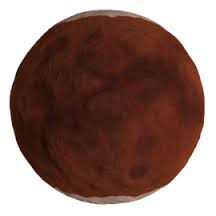Duna

Duna is the fourth planet of the Kerbol system. It is the Mars analog for Kerbal Space Program and is mostly red with polar icecaps. It has one natural satellite; Ike. Due to Ike's size and proximity, Ike and Duna are almost tidally locked to each other. Making Ike look like its slinging left and right when Duna rotates.
With proper aerobraking, a round trip from Kerbin to Duna's orbit and back requires roughly 1700 m/s of delta-v, less than a round trip to any other planet. Duna is often the easiest planet to achieve encounters because of a low orbital inclination.hh8h8hiii
Topography
Duna's terrain ranges in altitude from 23 to 4740 meters. Its mountainous ranges are a peril to landing craft, especially considering the thin atmosphere, where very little aerobraking can be done safely. Duna's icy poles are quite expansive and are the result of a thin atmosphere.
Duna has several craters, but they appear quite eroded, presumably from wind. There is also a region with deep holes (some over 1km deep), which seem much too steep to be impact craters (maybe sinkholes?).
There are several maria (large regions of dark soil) at exactly 0 meters altitude. Their flatness and low altitude which allow for more aerobraking make them easy but boring landing locations.
Duna's surface contains anomolous features.
Atmosphere
Duna's atmosphere begins at 41,446 m. It is only 20% as dense as Kerbin's at altitude 0 and is even less dense (relative to Kerbin) at higher altitudes. This effect becomes especially noticeable at Duna's highest points, where its atmosphere is only 21% as dense as its atmosphere at altitude 0. (For comparison, on Kerbin, the atmosphere at the highest peaks is 45% as thick as at sea level.) This lack of density will cause parachutes to semi-deploy much lower, just over 10km for the Mk25 and just under 9km for all the other parachutes.
Info
| Orbital Characteristics | |
| Semi-Major Axis | 20 726 155 264 m (1) |
| Apoapsis | 21 783 189 163 m (1) |
| Periapsis | 19 669 121 365 m (1) |
| Orbital Eccentricity | 0.05 |
| Orbital Inclination | 0.06 ° |
| Argument of periapsis | {{{pe arg}}} ° |
| Longitude of the ascending node | {{{an arg}}} ° |
| Mean Anomaly | 3.14 rad (at 0s UT) |
| Siderial orbital period | 17 315 400 s |
| 200 d 9 h 50 m 0.1 s | |
| Synodic orbital period | 19 645 699 s |
| 227 d 9 h 8 m 19 s | |
| Orbital Velocity | 7 147 to 7 915 m/s |
| Physical Characteristics | |
| Equatorial Radius | 320 000 m |
| Surface Area | 1.2867964×1012 m2 |
| Mass | 4.5154812×1021 kg |
| Gravitational Parameter | 3.0136321×1011 m3/s2 |
| Density | 32 897.696 kg/m3 |
| Surface Gravity | 2.94 m/s2 |
| Escape Velocity | 1 372.41 m/s |
| Sidereal Rotation Period | 65 517.859 s |
| 18 h 11 m 57.9 s | |
| Sidereal Rotational Velocity | 30.688 m/s |
| Synchronous Orbit | 2 880.00 km |
| Sphere of Influence | 47 921 949 m |
| Highest elevation | 4740 m |
| Atmospheric Characteristics | |
| Atmosphere Present | Yes |
| Atmospheric Pressure | 20.3 kPa |
| 0.2 atm | |
| Scale Height | 3000 m |
| Atmospheric Height | 41 446.532 m |
| 2.0×10-7 atm | |
| Temperaturemin | -50.24 °C 222.91 K |
| Temperaturemax | -30.17 °C 242.98 K |
| Oxygen Present | No |